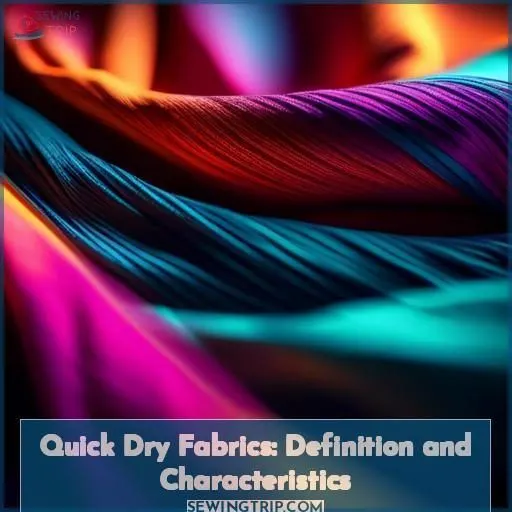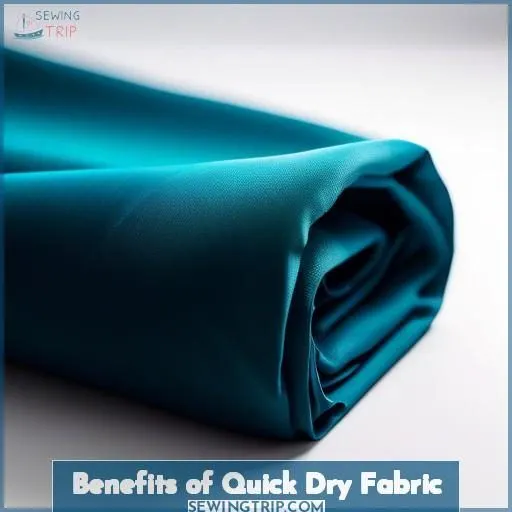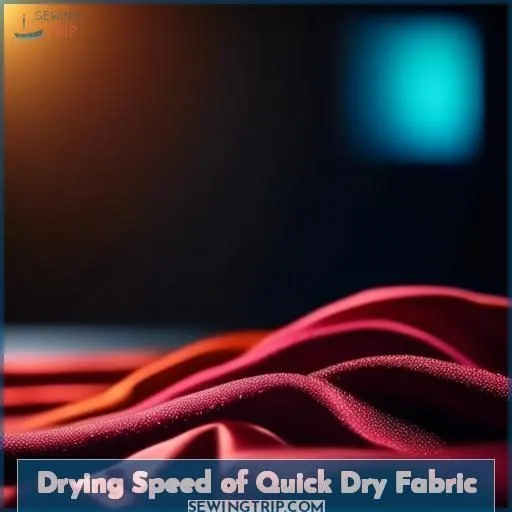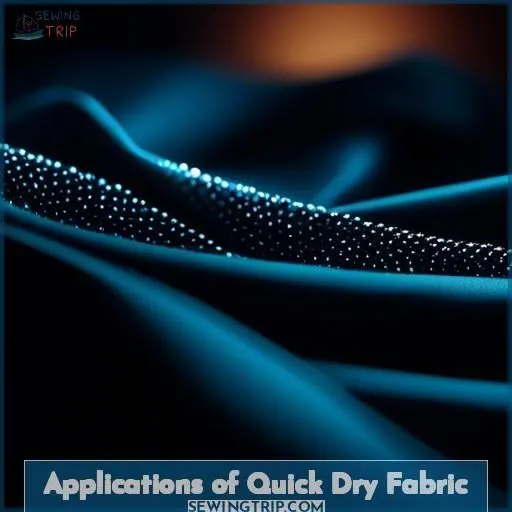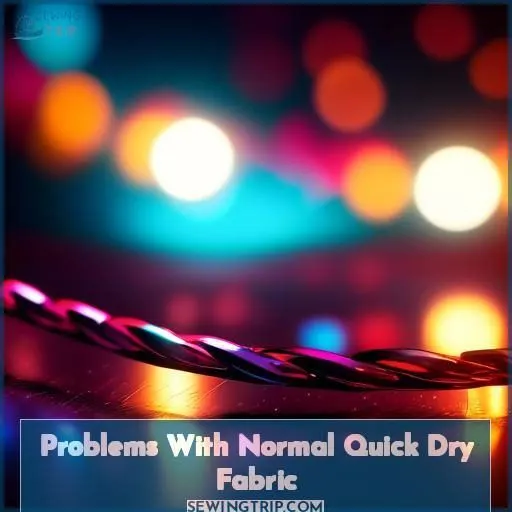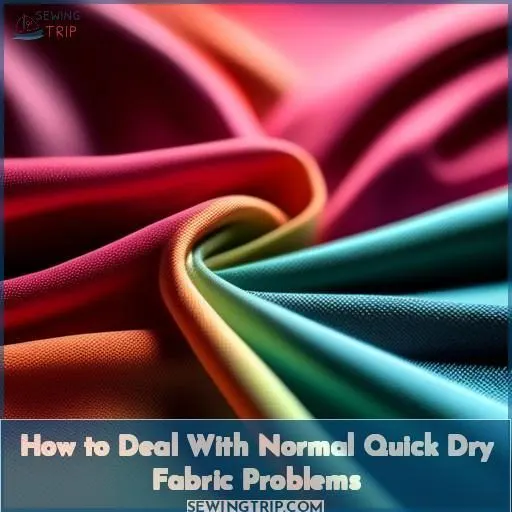This site is supported by our readers. We may earn a commission, at no cost to you, if you purchase through links.
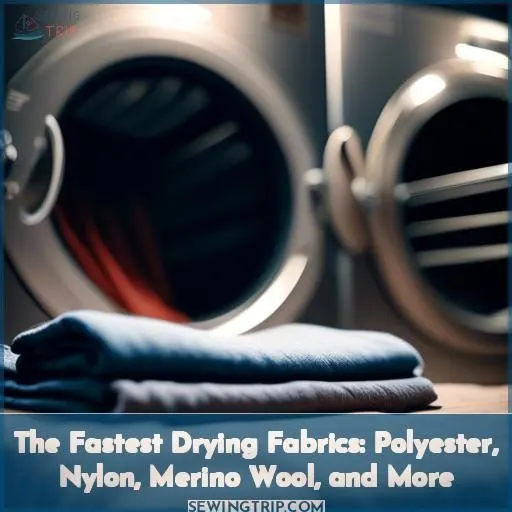
You’ll find that polyester dries the fastest among common fabrics, making it an excellent choice for active pursuits and humid environments.
This synthetic fiber wicks moisture away from the skin, allowing garments to dry completely within two hours.
Nylon follows close behind in drying speed, while merino wool is the fastest natural quick-dry fabric.
Cotton, though slower than synthetics, still qualifies as a quick-drying option.
Keep reading to discover more about quick-dry fabric characteristics, benefits, and applications.
Table Of Contents
- Key Takeaways
- What Fabric Dries the Fastest?
- What Fabric Dries the Fastest?
- Quick Dry Fabrics: Definition and Characteristics
- Benefits of Quick Dry Fabric
- Drying Speed of Quick Dry Fabric
- Applications of Quick Dry Fabric
- Problems With Normal Quick Dry Fabric
- How to Deal With Normal Quick Dry Fabric Problems
- How to Dry Quick-Dry Clothes When Traveling
- Frequently Asked Questions (FAQs)
- Conclusion
Key Takeaways
- Polyester is the overall fastest fiber in terms of drying speed, with polyester garments drying completely within two hours.
- Nylon is also a fast-drying fabric, but it takes longer than polyester to dry completely.
- Cotton is the fastest natural quick-dry fabric, drying within a few hours, but it’s slower than synthetic fabrics like polyester and nylon.
- The drying time for quick-dry fabric can also be influenced by factors such as the level of wetness, the location, and the climate.
What Fabric Dries the Fastest?
Polyester is the overall fastest-drying fabric, with the ability to go from wet to damp within minutes and dry completely in less than two hours.
What Fabric Dries the Fastest?
Regarding the fabrics that dry most rapidly, polyester excels. Nylon, merino wool, and cotton also possess quick-drying attributes, although they may not reach polyester’s astonishing drying velocity.
Polyester
Polyester, the champion of quick-dry fabrics, is your go-to for keeping sweat at bay. This synthetic marvel excels in moisture-wicking, pulling sweat from your skin faster than you can say dry. Ideal for those who crave comfort without compromise, polyester clothing guarantees your body temperature stays regulated, letting you focus on conquering your day, not dodging sweat patches.
Nylon
Nylon is a synthetic fabric that’s widely used in moisture-wicking and quick-dry clothing. It’s known for its durability and elasticity, which makes it ideal for high-performance garments.
Nylon is also resistant to water and dries quickly, which is a key feature for quick-dry fabrics. However, it has some drawbacks, such as lower abrasion resistance compared to polyester, making it prone to pilling.
It also has poor dimensional stability in heat, which can cause it to warp and lose its shape when exposed to high temperatures. Despite these issues, nylon remains a popular choice for quick-dry clothing due to its moisture-wicking properties and quick-drying capabilities.
Merino Wool
While nylon’s quick-drying prowess is impressive, merino wool steps up with its natural flair. It’s a sweat-wicking fabric that’s both lightweight and cozy, offering you comfort without the clamminess. Plus, its breathability and odor resistance mean you’ll stay fresh even after a full day’s hike.
- Merino wool allergies are rare, making it a safe choice.
- Resists shrinkage with proper care.
- Touted for its sustainability.
- Superior merino wool breathability keeps you cool.
- Natural odor resistance for those long, adventurous days.
Cotton
Cotton is a popular natural fiber that’s often used in clothing and textiles. It’s known for its breathability, absorbency, and strength, making it a versatile choice for various applications. However, the sustainability of cotton production is a topic of concern due to its environmental impact.
Cotton is grown in several climates and can be harvested easily. It’s washable, absorbent, and strong, making it suitable for a wide range of products. However, the conventional method of cotton production involves the use of pesticides and insecticides, which can be harmful to the environment and human health. Additionally, cotton requires a significant amount of water, much of which comes from irrigation, contributing to water scarcity in some regions.
To address these concerns, the cotton industry has been working on improving sustainability practices. U.S. cotton farmers, for example, have embraced new methods and innovations that have reduced pesticide applications by 50%, reduced irrigated water applications by 45%, and increased fiber production without expanding acreage. Research is also being conducted to enhance the innate drought tolerance of cotton plants and their resistance to predatory pests.
In terms of quick-dry fabrics, cotton isn’t the fastest-drying fabric compared to synthetic materials like polyester and nylon. However, it’s the fastest natural quick-dry fabric. The drying speed of cotton depends on usage, wetness, and location.
Quick Dry Fabrics: Definition and Characteristics
Quick-dry fabrics are designed to wick moisture away from your skin, keeping you dry and comfortable. These fabrics can be made from synthetic fibers like polyester and nylon, or natural fibers like merino wool and cotton, with synthetic fabrics being a relatively new invention.
Designed to Wick Moisture Away From the Skin
Quick dry fabrics are designed to manage moisture, keeping you dry and comfortable. They’re made from both natural and synthetic fibers, each with its own benefits.
Natural fibers like merino wool are hydrophilic, absorbing moisture and drying slowly. In contrast, synthetic fibers like polyester and nylon are hydrophobic, repelling moisture and drying quickly.
The choice between natural and synthetic fibers depends on your comfort considerations, environmental impact, and the specific moisture-management needs of your activity.
Made of Synthetic or Natural Fibers
Quick dry fabrics are designed to wick moisture away from the skin, keeping you dry in extreme weather or during strenuous activity. They can be made of natural or synthetic fibers, each with its own benefits.
Natural fibers like merino wool are warm, lightweight, odor-resistant, and cozy.
Synthetic fibers like polyester, nylon, and spandex are hydrophobic, durable, and affordable.
Man-made fibers like modal, thermal plastic elastin, and polyester are moisture-wicking, weather-suitable, and activity-specific, making them ideal for travel apparel, sportswear garments, and undergarments.
Includes Polyester, Nylon, Merino Wool, and Cotton
When you’re on the go, quick-dry fabrics like polyester and nylon are your best mates, drying faster than you can say flash flood. Merino wool and cotton tag along, offering a natural touch with a knack for breathability. Whether it’s travel shirts that shrug off sweat or travel pants with ergonomic flat-lock seams, these materials balance comfort with performance.
Synthetic Fabrics Are a Relatively New Invention
Artificial fabrics, such as polyester and nylon, are relatively recent creations in the realm of textiles. The story of artificial fabric can be traced back to the early 20th century when chemists embarked on experimenting with artificial materials. The first artificial fabric was invented in 1884 by William Henry Perkin, who stumbled upon a method to create aniline dyes from coal tar. However, it wasn’t until the 1930s that artificial fibers like nylon and polyester were developed, bringing about a profound change in the textile industry.
In recent years, there’s been a heightened focus on environmentally friendly and sustainable artificial fabrics. For example, recycled polyester is a more sustainable option compared to virgin polyester, as it eliminates the initial polluting process and helps reduce waste. Additionally, new technologies are being developed to create artificial fabrics with a reduced environmental impact, such as nettle fabric, which requires minimal water and chemicals to cultivate.
When considering the sustainability of artificial fabrics, it’s crucial to examine beyond the material itself. The production process, including the use of energy and resources, can have a significant impact on the environment. Brands that prioritize sustainable practices, such as efficient resource management and the circular economy approach, can help lessen the environmental footprint of artificial fabrics.
Benefits of Quick Dry Fabric
Quick-dry fabrics offer a wealth of advantages that make them perfect for active lifestyles and harsh weather conditions. Their ability to draw moisture from the body, control temperature, eliminate sweat marks and rashes, and shield against humidity guarantees that you remain dry, comfortable, and concentrated on your activities.
Hides Sweat Marks and Patches
Quick dry fabrics are a game-changer for moisture management, offering sweat control and comfort enhancement.
They’re designed to wick moisture away from the skin, keeping you dry and fresh.
Polyester, nylon, and merino wool are popular choices, each with its own benefits.
Polyester dries the fastest, while nylon is stretchy and strong.
Merino wool is cozy and odor-resistant.
These fabrics not only hide sweat marks and patches but also reduce odor, improving style and enhancing style.
Stays Dry in Extreme Weather or During Strenuous Activity
Quick dry fabric is a game-changer for those engaging in extreme sports or hiking in challenging weather conditions.
Its sweat absorption capabilities keep you dry during high-impact activities, ensuring you stay comfortable and focused on the task at hand.
The four-way stretch and thermoregulation properties of these fabrics make them ideal for camping clothing and hiking apparel, allowing you to tackle any terrain with ease.
Durable materials like polyester and nylon are perfect for extreme sports gear, providing the necessary protection and performance needed for these high-intensity activities.
Regulates Body Temperature
Quick-dry fabrics not only keep you dry but also regulate your body temperature, making them perfect for various activities.
They’re designed to wick moisture away from the skin, keeping you comfortable in humid conditions.
This feature can help reduce skin irritation and heat rashes, ensuring a comfortable range of motion.
High-quality fabrics like thermal underwear with heat-reflective omni-heat technology, flat-locked seams, and nirvana fabric provide an extra layer of comfort and performance.
Protects From High Humidity Levels
Just as regulating body temperature keeps you cool, quick-dry fabrics also shield you from the cling and discomfort of high humidity levels.
- Fabric breathability guarantees you stay fresh, dodging the sticky feeling.
- Odor resistance fights off the unwelcome scents that humidity loves.
- Thermal insulation maintains your comfort, whether the air is thick with moisture or dry as a bone.
Reduces Skin Irritation and Heat Rashes
Quick dry fabrics are designed to reduce skin irritation and heat rashes by wicking moisture away from the skin.
These fabrics are moisture-wicking, sweat-proof, and heat-regulating, providing an anti-chafing barrier.
They’re also UV-resistant, soft, and often feature thumb holes and vibrant color palettes.
Some quick dry fabrics even incorporate closed-cell foam for added comfort and air drying capabilities.
By wearing these fabrics, you can enjoy a more comfortable and irritation-free experience, especially during strenuous activities or extreme weather conditions.
Drying Speed of Quick Dry Fabric
When it comes to quick-dry fabrics, polyester reigns supreme as the overall fastest drying fiber, with polyester garments able to dry completely within two hours. Nylon follows closely behind polyester regarding drying speed, while merino wool and cotton, though slower than their synthetic counterparts, are considered the fastest drying natural fibers.
Polyester is the Overall Fastest Fiber
Polyester is the overall fastest fiber in terms of drying speed.
This makes it an exceptional option for applications where rapid drying is essential, such as sportswear, travel apparel, and undergarments.
The advantages of employing polyester include its capacity to conceal sweat marks and patches, remain dry in adverse weather conditions or during strenuous activity, control body temperature, shield against high humidity levels, and alleviate skin irritation and heat rashes.
The components used to manufacture polyester fabric are synthetic, rendering it a relatively novel invention compared to natural fibers such as cotton and wool.
Polyester Garments Can Dry Completely Within Two Hours
Polyester is the overall fastest fiber regarding quick drying. In actuality, polyester garments can dry completely within two hours. This makes polyester a popular choice for quick-dry fabrics, especially in travel apparel, sportswear, and undergarments.
Nylon is Slower Than Polyester but Still Fast-drying
Nylon is slower than polyester regarding drying speed, but it still falls into the category of fast-drying fabrics.
This synthetic material is known for its strength, durability, and resistance to moisture.
When compared to polyester, nylon tends to take a bit longer to dry completely. However, it remains an excellent choice for quick-dry clothing due to its water-resistant properties and ability to wick away moisture.
Cotton is the Fastest Natural Quick-dry Fabric
When you’re packing for the slopes, don’t overlook cotton’s quick-dry limitations.
While it’s the Usain Bolt of natural fibers, drying faster than its plant-based pals, it can’t outrun synthetics.
Blends are stepping up, marrying cotton’s comfort with the speed-demon drying prowess of polyester, aiming for that ski jacket sweet spot.
Keep an eye out for future innovations enhancing cotton’s aesthetic and performance potential.
Drying Time Depends on Usage, Wetness, and Location
Drying time for quick-dry fabric is affected by usage, wetness, and location.
The drying speed of quick-dry fabric can vary noticeably depending on the specific conditions.
For instance, polyester is the overall fastest fiber, with polyester garments drying completely within two hours.
Nylon is also a fast-drying fabric, but it takes longer than polyester.
Cotton is the fastest natural quick-dry fabric, drying within a few hours, but it’s slower than synthetic fabrics like polyester and nylon.
The drying time for quick-dry fabric can also be influenced by factors such as the level of wetness, the location, and the climate.
For example, if the fabric is heavily soaked, it may take longer to dry than if it’s only slightly damp.
Similarly, drying time can be affected by the temperature and humidity of the environment.
In general, quick-dry fabric dries faster than traditional fabrics like cotton, which can take up to 24 hours to dry completely.
However, the exact drying time will depend on the specific fabric and the conditions in which it’s being dried.
Applications of Quick Dry Fabric
Quick-dry fabrics like polyester, nylon, and merino wool are ideal for travel apparel, sportswear garments, towels, and undergarments. Their moisture-wicking and fast-drying properties keep you comfortable and dry during activities or in humid environments.
Travel Apparel
When packing for your next adventure, quick-dry travel apparel is a must-have.
Lightweight clothing that wicks moisture away from your skin is perfect for outdoor activities and unpredictable weather conditions.
Quick-dry fabric is ideal for your travel wardrobe, keeping you comfortable and dry, even when you’re on the go.
From moisture-wicking garments to outdoor clothing, these fabrics have got you covered, ensuring your journey is as comfortable as possible.
Sportswear Garments
Quick dry fabrics are designed to reduce the need for frequent washing by repelling stench-causing bacteria often associated with sweating. They’re a game-changer in the sportswear industry, enhancing athletic performance, durability, and sustainability.
- Moisture-wicking properties: Quick dry fabrics are engineered to efficiently absorb sweat from the body and scatter it across the fabric’s surface, allowing it to quickly evaporate.
- Breathability: These fabrics have a loose-knit or breathable weave, which allows fresh air to pass through easily and evaporate moisture.
- Comfort: Quick dry fabrics can be crafted from various materials, including synthetic fibers like polyester, nylon, and merino wool, and natural fibers like cotton.
- Durability: They’re resistant to shrinking, stretching, and wear, ensuring long-term usage.
Quick dry fabrics have revolutionized sportswear by improving performance, enhancing durability, and contributing to sustainability.
Towels and Undergarments
Quick-dry fabric is essential for travel and sportswear, as it allows for easy hand washing and quick drying. It’s made from synthetic materials like polyester**, nylon, and merino wool, and natural fibers like cotton. Polyester is the overall fastest-drying fiber, with polyester garments drying completely within two hours. Nylon is also fast-drying, but slower than polyester. Cotton is the fastest natural quick-dry fabric, and drying time depends on usage, wetness, and location.
Towels and undergarments made from quick-dry fabric have moisture-wicking properties, which keep wearers dry and comfortable. They also reduce friction, preventing blisters and rashes. Quick-dry undergarments have anti-bacterial properties and are odor-resistant, making them ideal for travel and outdoor activities.
When traveling, it’s recommended to hand wash and hang dry quick-dry clothes overnight, place them in direct sunlight with airflow, or hang them from a backpack to air-dry if leaving before they’re completely dry. Humidity can slow down drying time, so it’s best to avoid packing wet clothes.
Some popular quick-dry travel fabrics include polyester, nylon, merino wool, and cotton blends. Polyester is hydrophobic and durable, while nylon is stretchy and blends well with merino wool. Merino wool is warm, lightweight, odor-resistant, and cozy, and cotton is hydrophilic and absorbs moisture but dries slowly.
Quick-dry clothing is ideal for travel because it allows for easy hand washing and quick drying, making it perfect for packing light and reusing items multiple times on a trip.
Problems With Normal Quick Dry Fabric
While quick-dry fabrics like polyester, nylon, and merino wool offer impressive moisture-wicking and fast-drying capabilities, they often lack breathability.
This poses challenges for sweat evaporation and comfort during intense activities.
Additionally, the production and disposal of synthetic fabrics contribute to environmental pollution.
This prompts concerns about their long-term sustainability.
At the same time, the aesthetic appeal of these performance fabrics can be limited.
This potentially restricts their versatility across different settings and occasions.
Not Breathable
When you’re gearing up for an adventure, you might find yourself wrestling with the trade-offs of quick-dry fabrics. Here’s the scoop:
- Fabric breathability often takes a backseat, leaving you feeling like you’re wrapped in plastic wrap.
- Moisture management sounds great on paper, but in reality, it can feel like a sauna inside your shirt.
- Comfort comparison? Traditional fabrics might win the cozy contest hands down.
- Synthetic alternatives promise the world, yet sometimes deliver a greenhouse effect, raising questions about health implications.
Negative Environmental Impact
Quick dry fabrics have revolutionized the way we dress, especially for those who engage in sports or outdoor activities. However, these fabrics, often made from synthetic materials like polyester and nylon, come with a darker side that has been gaining attention in recent years. The environmental impact of these fabrics is significant, and it’s imperative to understand the issues associated with them.
Sustainability Concerns: The production of synthetic fabrics, such as polyester and nylon, contributes to a substantial amount of pollution. These materials are derived from petroleum, a non-renewable resource, and their production requires a significant amount of energy and water. Additionally, the disposal of these fabrics contributes to landfill waste and microplastic pollution.
Microplastic Pollution: When synthetic fabrics are washed, they shed tiny plastic fibers called microplastics. These fibers are small enough to pass through wastewater treatment systems and end up in our oceans, where they can harm marine life and enter the food chain. This has led to concerns about the long-term effects of microplastics on human health.
Biodegradable Alternatives: As awareness of the environmental impact of synthetic fabrics grows, there’s a push for more sustainable alternatives. Some companies are exploring the use of biodegradable materials, such as bamboo and hemp, which have a lower environmental impact and can decompose naturally.
Ethical Production: The production of synthetic fabrics often involves labor practices that are less than ethical. Many workers in the textile industry are subjected to low wages, long hours, and poor working conditions. Consumers can make a difference by supporting brands that prioritize ethical production and fair labor practices.
Water Conservation: The production of synthetic fabrics requires a significant amount of water. As the world faces increasing water scarcity, it’s imperative to take into account the water footprint of the fabrics we wear.
To mitigate the negative environmental impact of quick dry fabrics, it’s imperative to support brands that prioritize sustainability, ethical production, and the use of biodegradable materials. Additionally, consumers can take steps to reduce their own impact, such as washing synthetic fabrics less frequently and properly disposing of them when they’re no longer usable.
Limited Aesthetic Potential
Quick-dry fabrics, such as nylon and polyester, are highly efficient materials that can keep you dry and comfortable during physical activities. However, they face a common criticism: limited aesthetic potential. While these fabrics excel in performance, they may not be the most visually appealing options for fashion-conscious individuals.
When it comes to quick-dry fabrics, there are a few key things to think about:
- Materials: Nylon and polyester are the most common synthetic fabrics used for quick-drying garments. They’re hydrophobic, meaning they repel water rather than absorbing it, which contributes to their quick-drying properties.
- Performance: Quick-dry fabrics are designed to wick moisture away from the skin, keeping you dry and comfortable during strenuous activities. They’re ideal for athletic wear, travel clothing, and casual wear.
- Environmental Impact: While quick-dry fabrics offer numerous benefits, they also have a negative environmental impact. Polyester and nylon account for over 60% of the pollution caused by synthetic fibers.
- Aesthetic Considerations: Quick-dry fabrics may not be the most visually appealing options, but new styles are being developed to address this issue. As the technology advances, manufacturers are working to improve the aesthetic potential of quick-dry fabrics.
How to Deal With Normal Quick Dry Fabric Problems
You may be wondering, What’s ®, and how is it different? ® is a innovative quick-dry fabric designed to address the common issues of breathability, environmental impact, and aesthetic limitations associated with traditional synthetic quick-dry materials like polyester and nylon.
What is ®?
The ® symbol is a laundry symbol that indicates the item should be dry cleaned.
It’s a circle with a cross through it.
This symbol is different from the circle icon, which indicates that an item can be dry cleaned.
The ® symbol is used when the garment cannot be machine-washed or hand-washed.
It requires professional dry cleaning to maintain its quality and appearance.
How is ® Different?
® is a type of quick-dry fabric that’s known for its unique properties and innovative features. Unlike traditional quick-dry fabrics, ® is designed to be more breathable and sustainable, addressing some of the common issues associated with synthetic quick-dry materials.
- Breathability: ® is highly breathable, which means it allows air to flow through the fabric, helping to keep the wearer cool and comfortable. This is particularly important for activewear, as it can help prevent skin irritation and heat rashes caused by sweat and moisture build-up.
- Sustainability: ® is made using closed-loop production processes, which minimize the environmental impact of the fabric. This is in contrast to some synthetic quick-dry fabrics, which can contribute to deforestation and pollution. By opting for ®, consumers can make more sustainable choices that align with their values.
- Ethical Production: The production of ® is designed to be ethical, ensuring that workers are treated fairly and that the fabric is produced in a socially responsible manner. This is a key concern for many consumers, who want to support brands that prioritize ethical production practices.
- Future Developments: As the demand for sustainable and eco-friendly fabrics continues to grow, ® is likely to be at the forefront of future developments in the quick-dry fabric industry. This could include further improvements in breathability, moisture-wicking, and environmental sustainability.
How to Dry Quick-Dry Clothes When Traveling
When traveling with quick-dry clothes, hand washing and hanging them to dry overnight is the most convenient method. However, you can speed up drying by placing the garments in direct sunlight with good airflow; just be mindful that high humidity will slow the drying process.
Hand Wash and Hang Dry Overnight
After tackling quick-dry fabric quirks, let’s delve into overnight drying.
When you’re on the go, hand washing and hang drying can be a lifesaver.
Simply rinse your gear, give it a gentle wring, and drape it up.
Overnight, the magic happens—your travel essentials will be ready to roll by morning, thanks to the impressive drying speed of these savvy textiles.
Place in Direct Sunlight With Airflow
When drying quick-dry clothes, it’s essential to place them in direct sunlight with airflow to expedite the drying process.
Sunlight provides heat, which can help evaporate moisture from the fabric more efficiently.
Additionally, airflow helps eliminate moisture-laden air and replace it with drier air, further accelerating the drying process.
However, high humidity levels can decelerate the drying time, as the air is already saturated with moisture.
In such cases, you may need to rely on indoor drying methods, such as using dehumidifiers or placing clothes near heat sources like radiators or dryers.
Humidity Slows Drying Time
When you’re on the go, remember that humidity’s like an uninvited guest at a picnic—it can dampen your travel vibe by slowing down the drying time of your clothing. To outsmart the muggy air, always check the local humidity levels; they’re the secret sauce to predicting how quickly your quick-dry fabrics will be ready for your next adventure.
Avoid Packing Wet Clothes
Avoid packing wet clothes to save space and time. Here’s what you should do:
- Hand wash and hang dry overnight: Use biodegradable soap and let clothes dry naturally.
- Place in direct sunlight with airflow: Sunlight speeds up the drying process.
- Humidity slows drying time: Be patient or dry clothes in a different location.
- Hang from backpack to air-dry if leaving before clothes are dry: Use a backpack as a drying rack.
These packing strategies, drying equipment, and travel hacks are must-have items for your next adventure.
Frequently Asked Questions (FAQs)
How does the drying speed of quick-dry fabric compare to cotton?
You’ll be amazed – polyester dries in just 2 hours, while cotton takes 6-8 hours! Quick-dry fabrics wick moisture and evaporate rapidly for maximum comfort during adventures or workouts. Say goodbye to that damp, clingy feeling with technical performance wear.
What are the most popular materials for quick-dry clothing?
The most popular quick-dry materials are polyester, nylon, and merino wool. You’ll stay cool and dry with these synthetic or natural fibers—perfect for active lifestyles.
How does the environmental impact of quick-dry fabrics compare to natural fibers?
Quick-dry fabrics like polyester leave a bigger environmental footprint than natural options. You’re trading convenience for planet-unfriendly production and poor biodegradability. Go for merino wool or organic cotton if sustainability’s a priority.
What are the best quick-dry clothing options for travel?
For quick-drying travel clothes, go with polyester, nylon, or merino wool. Bluffworks pants, ExOfficio underwear, and Darn Tough socks are excellent choices that’ll keep you comfy and dry on any adventure.
How does the drying speed of quick-dry fabric vary with different usage and conditions?
Quick-dry fabric dries faster when exposed to sunlight and airflow. High humidity slows down drying time, so you’ll want good ventilation. Usage affects wetness levels – sweaty clothes take longer to dry than lightly damp ones.
Conclusion
Ultimately, if you’re seeking the fastest drying fabric for your active lifestyle or travels, polyester reigns supreme.
Polyester dries completely within two hours after getting wet.
Nylon and merino wool closely follow, offering superior moisture-wicking capabilities compared to traditional cotton.
By understanding the drying speeds and characteristics of quick-dry fabrics, you can make informed decisions to stay comfortable and dry in any environment.

